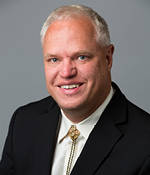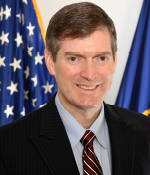Each November, the Bulletin highlights the importance of lung cancer screening in combatting one of the deadliest cancers in the world. Each year, more people die of lung cancer than of colon, breast and prostate cancers combined. It’s fitting then that on Nov.11, we also celebrate active duty and veteran military service members, who have a significantly higher risk of developing lung cancer. An estimated 7,700 veterans are diagnosed with lung cancer each year by the U.S. Department of Veterans Affairs (VA) alone, and incidence rates in veterans are 76% higher than those who have never served.
There are several reasons for this, explains Dan Davis, MD, FACR, chief of radiology at the Robert J. Dole VA Medical Center in Wichita, Kansas, and a member of the ACR Veterans Affairs (VA) Committee. “Veterans and servicemembers have a higher rate of smoking than civilians, and cigarette smoking is linked to 90% of lung cancer deaths,” according to Davis. Other factors include exposure to chemicals and other toxic irritants during combat — things veterans have experienced as part of their day-to-day job, says Greg Mogel, MD, FACR, chief medical officer for 4D Medical, a company working to develop new lung screening methods to detect occupational diseases in veterans, and also a member of the ACR VA Committee.
 |
 |
 |
 |
| Dan Davis, MD, FACR | Greg Mogel, MD, FACR | Kelly Biggs, MD | Ian A. Weissman, DO, FACR |
Getting to Work
Because of the high risk among servicemember populations, the VA has ramped up its efforts within the last ten years to increase lung cancer screening awareness and save more lives. This includes screening collaborations such as the VA-Partnership to Increase Access to Lung Screening (VA-PALS), which pioneered lung cancer screening programs at VAs. “Lung cancer screening is a priority of the VA because lung cancer is the leading cause of cancer-related death among veterans. The VA is raising awareness about lung cancer screening because when lung cancer is caught early, patient outcomes improve,” says Ian A. Weissman, DO, FACR, chair of the ACR VA Committee, immediate past chair of the ACR Commission on Patient- and Family-Centered Care Commission’s Outreach Committee, member of the ACR Well-Being Committee, and member of the ACR CSC.
"The VA has been a part of major education and communication efforts," says Kelly Biggs, MD, radiologist at James E. Van Zandt VA Center in Altoona, Penn., and member of the ACR VA Committee. In addition to national partnerships and messaging campaigns with organizations such as the American Cancer Society and the GO2 Foundation for Lung Cancer, much work is done on the ground by individual VA centers.
Lung cancer screening is a priority of the VA because lung cancer is the leading cause of cancer-related death among veterans.
Over 110 VA medical facilities participate in screening outreach awareness efforts during November. “Our center has its own awareness day,” Biggs explains. “The regional lung cancer screening navigator visits and makes a presentation for veterans, and a scheduler is on-site to help newly enrolled patients set up their scans.” Adds Davis, “Lung cancer screening coordinators are a huge part of awareness and education. In addition to providing individual counseling, they also speak at homeless veteran centers, weight management classes and many other veteran events.”
The radiologists at James E. Van Zandt VA have also made a point of partnering with primary care providers and educating them on the benefits and eligibility criteria for lung cancer screening. “They’re our first-line agents for promoting awareness and participation,” says Biggs.
"The VA has also worked to improve the lung cancer screening process and make it easier. VA electronic health records track screening eligibility for veterans based on their age and smoking history," says Davis. Most veterans generally see their VA provider at least annually, and, during this time, the provider will get a reminder regarding whether the patient is eligible for lung cancer screening, and during the appointment, the provider will conduct a formal tobacco pack year assessment to determine next steps, he explains. “Most VA centers now have their own lung cancer screening program, where patients can access everything in one place: Lung cancer screening coordinators, smoking cessation counseling, screening, surgery, even multidisciplinary lung cancer screening conferences if they’re needed — veterans can access all of this through the VA. At Dole, we strive to have our time from screening to diagnosis at less than 30 days,” notes Davis.
Making Strides
The VA’s efforts have paid off. A recent study found from 2010–2017, lung cancer survival rates in the VA increased significantly. Lung cancer is also being diagnosed earlier, which increases the chances of survival — the number of cancers diagnosed at stage I grew 68%, while the number of cancers diagnosed at stage IV decreased by 11%.
“We’ve been very committed to improving lung cancer screening, and we’re very proud of the numbers at our VA,” says Davis. At Dole, 88.5% of eligible veterans with some smoking history have had formal tobacco pack year assessments, and of those deemed eligible, 83% are enrolled in our lung cancer screening program, he adds. “We have a 93.5% adherence rate for follow-up scans, largely due to the education efforts of our lung cancer screening coordinators.”
The Altoona program has seen similar successes, reports Biggs. “Our adherence rate is 96.8%, and our annual volume increased 30 times since we first launched our lung cancer screening program in 2021.”
Continuing the Mission
Even though this is a success story, there is still much work to be done, agree Mogel, Davis and Biggs, and not just at VA centers. “Every radiologist is a veteran provider at some point,” says Mogel. “Even if you don’t know it, several of your patients are likely veterans.” Non-VA radiologists can greatly help education efforts, says Davis. Veterans still hold misconceptions about lung cancer screening benefits — one VA study found patients believed lung cancer screening was just as good as, if not better than, quitting smoking as a way of preventing lung cancer. “Continuing to spread the word about lung cancer screening to eligible patients is key, whether they’re veterans or not,” Davis notes.
Biggs and Davis suggest radiologists can provide help during non-lung cancer screening exams. “It’s not rare for radiologists to be reading standard chest CTs and detect incidental nodules in the lungs. If, based on Fleischner criteria, a radiologist would recommend a 12-month follow-up of a nodule, the radiologist could alternatively recommend enrollment in the lung cancer screening program, if eligible, with follow-up exam in 12 months,” Davis explains. Adds Biggs, “Radiologists can also identify potentially eligible veterans undergoing other routine imaging and note their eligibility for lung cancer screening in the impression of the report.”
More research and awareness are also needed on military-related risk factors for lung cancer beyond smoking, says Mogel. “Lung cancer is common even in veterans who aren’t smokers due to exposure to toxic chemicals and other irritants. But because they aren’t smokers, they don’t qualify for traditional lung cancer screening. That’s a big gap of patients to be concerned about.”
Veteran patients have unique needs due to their service, and, as a result, radiologists are uniquely important in serving those populations, says Mogel. “We know lung screening saves lives and it’s vital for at-risk patients such as these to get screening. As experts in imaging, we need to be the ones who help ensure these patients receive potentially lifesaving care.”
Dan Davis, MD, FACR, would like to acknowledge the roles of Carol Manes, RN, and Dana Cotter, RN, in the development of this article. The statements presented are those of Dan Davis, MD, FACR, and Kelly Biggs, MD, and do not necessarily state or reflect those of the United States government.
